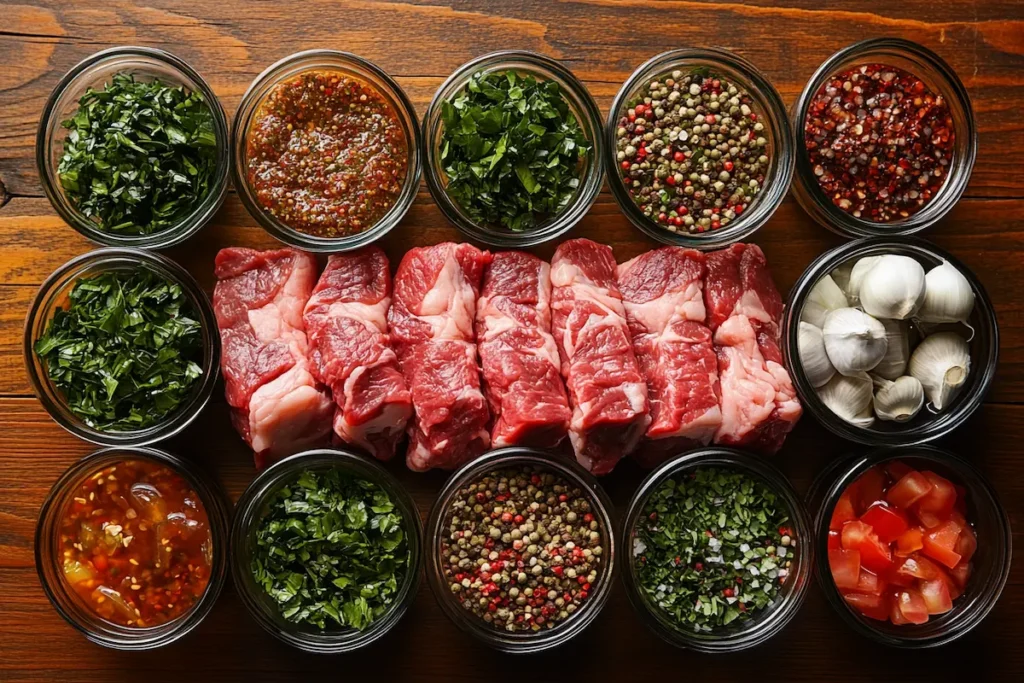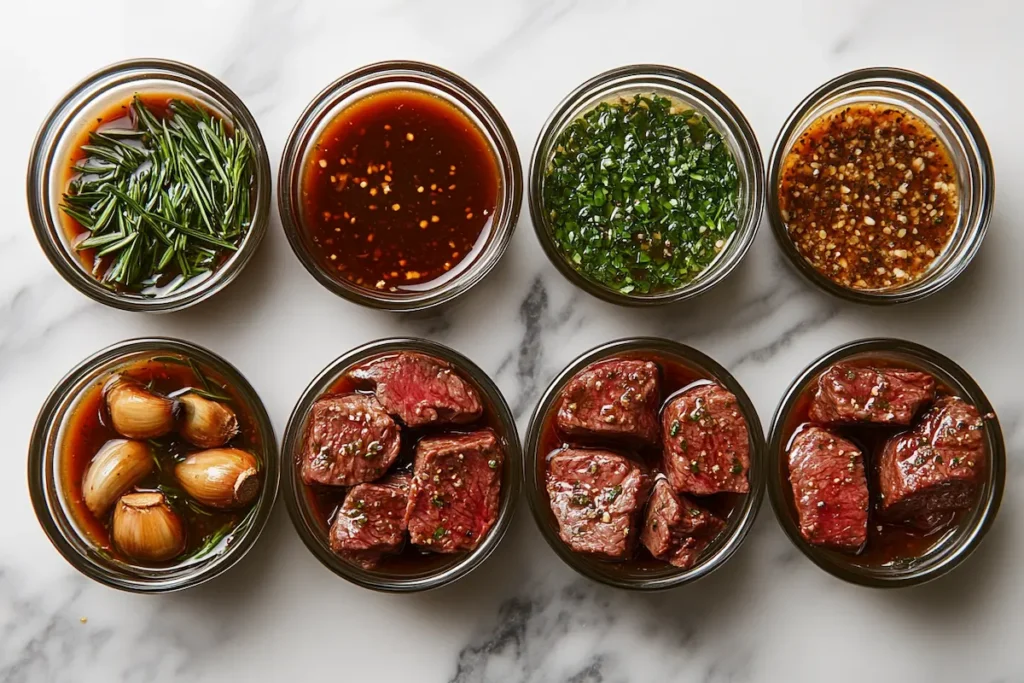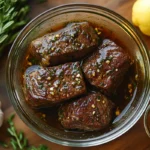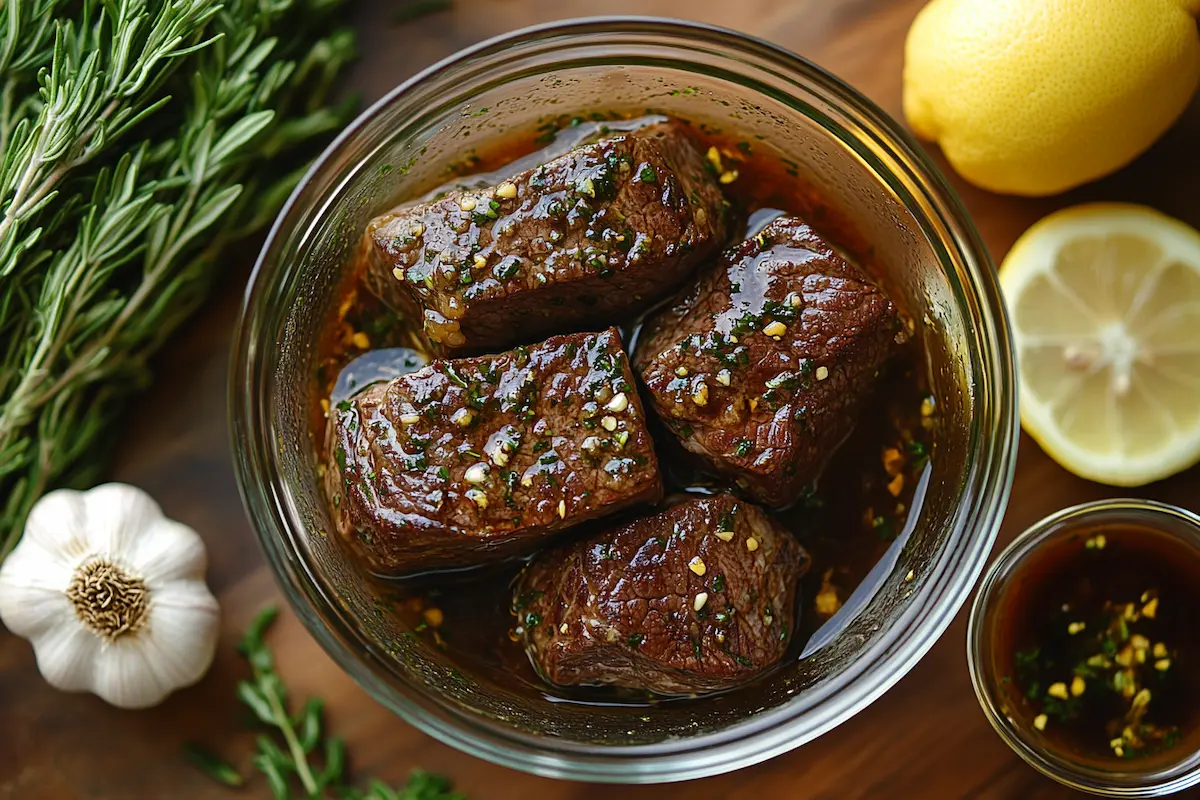Marinating steak is an art that can take your cooking game to the next level. Whether you’re preparing a quick weeknight meal or planning a fancy dinner, marination unlocks flavors and tenderizes your steak to perfection. But here’s the million-dollar question: Can you marinate steak in a bowl? This guide answers that and more, diving deep into the methods, best practices, and even common pitfalls.
We’ll cover everything from the basics of marination to the finer details of choosing the right container. Let’s get started with the fundamentals.
Table of contents
What is Marinating?
What Does Marinating Mean?
Marinating is a tried-and-true technique where you soak meat in a seasoned liquid to infuse it with flavor and enhance its texture. A good marinade typically consists of three key components: acids, oils, and spices. Together, these elements work their magic, breaking down the meat’s fibers and ensuring every bite is tender and flavorful.
Think of it as giving your steak a flavor bath it’s a simple, effective way to elevate its taste.
Common Ingredients in Steak Marinades
A great marinade starts with a few staples, each playing a vital role:
- Acid: Think lime juice, vinegar, or buttermilk. These ingredients tenderize the steak, making it easier to chew and juicier.
- Oil: Olive oil is the go-to, but sesame oil or other neutral oils work well. Oils help the flavors spread evenly and prevent the steak from drying out.
- Seasonings: Garlic, soy sauce, paprika, and even Worcestershire sauce create depth and complexity.
- Sweeteners (optional): A touch of honey or brown sugar can balance out the acidity and add caramelization.
Why Marination Matters
So why go through the trouble? Well, marination does more than add flavor. It also tenderizes the meat, especially tougher cuts like flank or skirt steak. The acidic ingredients help break down muscle fibers, while oils and spices ensure the steak stays juicy and flavorful.
Why Use a Bowl for Marinating?
Convenience and Practicality of Using Bowls
When it comes to marinating steak, bowls have been a kitchen staple for generations. They’re readily available, easy to clean, and can hold a decent amount of marinade and steak without spilling over. But why do many home cooks reach for a bowl instead of alternatives like plastic bags or glass dishes?
The primary reason is convenience. Bowls allow you to mix, adjust, and monitor your marinade more easily. You don’t have to worry about punctures or leaks like you might with plastic bags. Additionally, using a bowl makes stirring or flipping the steak to ensure even marination a breeze.
For instance, if you’re experimenting with a soy-based marinade or a citrusy mixture, a bowl lets you see exactly how much marinade is covering your steak. Plus, when the bowl is made of non-reactive material, it preserves the integrity of your marinade and prevents unwanted chemical interactions.
Size and Material Considerations for Bowls
The size of your bowl matters just as much as its material. Ideally, the bowl should be large enough for the steak to sit comfortably but small enough for the marinade to fully cover the meat. Shallow bowls might leave portions of your steak exposed, leading to uneven flavor distribution.
Material is another critical factor. Non-reactive bowls, such as those made of glass, ceramic, or certain types of plastic, are the best options. Avoid using metal bowls, especially those made of aluminum or copper, as they can react with acidic ingredients like vinegar or citrus, altering the taste and potentially damaging the bowl.
If you’re looking for more cooking insights, check out Steak Burrito Bowl Recipes on Blink Recipes for meal ideas that pair perfectly with marinated steak.
Comparing Marinating Methods
Bowl vs. Plastic Bag: Which is Better?
Ah, the age-old debate should you use a bowl or a plastic bag for marinating? Each method has its strengths, but bowls offer several distinct advantages. Plastic bags are often praised for being disposable and minimizing cleanup. However, they can leak or break, and they’re not environmentally friendly.
Can you marinate steak in a bowl? Absolutely, and here’s why it might be the better choice. Bowls are sturdier, reusable, and don’t create extra waste. They’re also better for marinating larger cuts of meat since they can hold both the steak and marinade without the risk of spills.
On the other hand, plastic bags allow for a snug fit, which ensures the marinade is in constant contact with the steak. This can slightly speed up the marinating process. But if you’re patient and prefer a sustainable option, bowls are the way to go.
Bowl vs. Glass or Ceramic Dishes
Now, let’s compare bowls to glass or ceramic dishes. While glass and ceramic dishes are also non-reactive, they often lack the depth of a bowl, making it harder to stir or flip the steak. Bowls excel in versatility they’re deep enough to submerge the steak fully and leave room for adjustments.
Glass dishes, while visually appealing, are better suited for baking or serving. If you plan to marinate and immediately transfer the steak to the oven, then a glass dish might save time. But for long marination times, bowls remain a more practical and mess-free option.
Whether you’re whipping up a quick soy steak marinade or preparing for a BBQ, the choice of container can impact your results. Using a bowl is not only feasible it’s often the best choice for hassle-free marination.

Best Practices for Marinating in a Bowl
Choosing the Right Bowl Material: Glass, Metal, or Plastic?
So, can you marinate steak in a bowl? Yes, you can! But choosing the right bowl is critical to getting the best results. Not all materials are created equal, and some can affect your marinade’s flavor or safety.
- Glass bowls are a top choice for marinating. They’re non-reactive, which means acidic ingredients like vinegar or citrus won’t alter the taste of your marinade. Plus, they’re easy to clean and don’t absorb odors.
- Ceramic bowls work similarly to glass, offering a safe and non-reactive surface. However, they can be heavier and more fragile.
- Plastic bowls are lightweight and convenient, but make sure they’re BPA-free and food-safe to avoid leaching chemicals into your marinade.
- Metal bowls should generally be avoided, especially aluminum or copper, as they react with acids and can leave an unpleasant metallic taste. Stainless steel is an exception and can be used safely.
To sum up, glass and ceramic are ideal for marinating, while plastic works in a pinch. Avoid metal unless it’s stainless steel.
How to Ensure Even Marination
Even marination is the key to achieving rich, consistent flavor throughout your steak. Here’s how to do it:
- Submerge the Steak Fully: The steak should be completely covered by the marinade. If your bowl is too shallow, flip the steak halfway through to ensure both sides get equal exposure.
- Stir Occasionally: Gently stir or agitate the marinade every couple of hours to redistribute the flavors evenly.
- Use the Right Marinade-to-Steak Ratio: A good rule of thumb is about 1 cup of marinade for every pound of steak.
And remember: Timing matters! Marinate tougher cuts like flank steak for longer, while tender cuts like ribeye need less time.
Food Safety Tips
Marinating in a bowl is convenient, but food safety is paramount. Always refrigerate your steak while it marinates to prevent bacteria growth. Avoid leaving it out at room temperature for extended periods.
Additionally, never reuse leftover marinade without boiling it first. If you want to use it as a sauce, bring it to a boil to kill any harmful bacteria.
Common Mistakes When Marinating Steak
Over-Marinating or Under-Marinating
One of the biggest mistakes cooks make is over-marinating their steak. Yes, it’s tempting to let the flavors soak in for hours or even days but too much marinating can actually ruin the texture. Acidic ingredients can break down the meat’s fibers excessively, leaving it mushy and unpleasant.
On the flip side, under-marinating won’t give you the flavor you’re aiming for. Always allow enough time for the marinade to penetrate. Typically, 30 minutes to 24 hours is ideal, depending on the steak’s thickness.
💡For more recipes, follow me on Facebook and Pinterest.
Using the Wrong Type of Bowl or Marinade
Believe it or not, the bowl you use can make or break your marinade. Reactive bowls (like aluminum or copper) can interfere with the marinade’s acidity, leaving your steak with an unwanted metallic taste. This is why non-reactive materials like glass or ceramic are highly recommended.
Another common mistake is using a poorly balanced marinade. If your mixture is too acidic or salty, it could overpower the natural flavors of the steak. Aim for a blend of acid, oil, and seasoning that complements, rather than masks, the meat’s taste.
For more inspiration and meal ideas, check out Steak Burrito Bowl Recipes on Blink Recipes.
FAQs About Marinating Steak in a Bowl
Can You Marinate Steak in a Bowl?
Absolutely! Can you marinate steak in a bowl? Of course, and it’s one of the simplest methods to get started. Bowls are versatile, easy to clean, and can hold both the marinade and steak securely. Just make sure to use a non-reactive bowl, such as one made from glass, ceramic, or BPA-free plastic. Avoid metal bowls unless they’re stainless steel, as acidic ingredients can react with the surface and ruin the flavor.
Is It Better to Marinate in a Bowl or Bag?
Both bowls and plastic bags have their pros and cons. Bowls are reusable, environmentally friendly, and allow you to monitor the marination process more easily. On the other hand, plastic bags are great for ensuring the marinade stays in constant contact with the steak, as you can squeeze out excess air for a tighter fit. Ultimately, it comes down to personal preference and convenience.
Is It Okay to Marinate Meat in a Metal Bowl?
Not all metal bowls are suitable for marinating. Reactive metals like aluminum and copper can interact with acidic ingredients in your marinade, altering both the taste and safety of your dish. However, stainless steel bowls are non-reactive and can be safely used for marinating meat, including steak.
Can You Marinate in a Glass Bowl?
Yes, glass bowls are one of the best choices for marinating steak. Glass is non-reactive, easy to clean, and doesn’t absorb odors or flavors. It’s a fantastic option for marinating with acidic ingredients like citrus or vinegar, ensuring your steak absorbs only the intended flavors.
Recipes and Examples
Simple Marinades for Beginners
If you’re just starting out, try a simple marinade with ingredients you likely already have in your pantry. Here’s a quick recipe:
- Ingredients:
- ½ cup soy sauce
- ¼ cup olive oil
- 2 tablespoons lemon juice
- 2 cloves garlic, minced
- 1 teaspoon black pepper
Mix the ingredients in a glass bowl, add your steak, and marinate for 30 minutes to 2 hours. It’s foolproof and delicious!

Advanced Steak Marinades for Special Occasions
Want to impress your guests? Opt for a more complex marinade that layers flavors. Here’s an idea:
- Ingredients:
- ⅓ cup balsamic vinegar
- ¼ cup Worcestershire sauce
- 2 tablespoons Dijon mustard
- 2 tablespoons honey
- 1 teaspoon smoked paprika
- 1 sprig of fresh rosemary
Combine the ingredients in a ceramic bowl and marinate the steak for at least 4 hours or overnight for the best results. The balance of sweet, smoky, and tangy flavors is sure to wow anyone at your table.
For more steak inspiration, check out recipes like Steak Burrito Bowls on BlinkRecipes.
Conclusion: The Best Way to Marinate Steak in a Bowl
Summarizing the Key Points
Can you marinate steak in a bowl? Without a doubt, you can, and it’s one of the easiest and most effective methods to prepare a flavorful meal. Bowls are versatile, convenient, and allow for easy adjustments during the marination process. By choosing the right material like glass, ceramic, or BPA-free plastic you ensure that your marinade enhances the steak without introducing unwanted flavors.
Throughout this guide, we’ve explored why bowls are a practical choice, compared marinating methods, and shared helpful tips for even flavor distribution. From simple soy-based marinades to more complex balsamic blends, the right marinade and technique can elevate your steak to restaurant-quality perfection.
Final Tips for Success
To get the most out of marinating in a bowl, always refrigerate the steak, avoid over-marinating, and select non-reactive materials for your container. Whether you’re prepping for a quick dinner or a special occasion, using a bowl ensures the process is stress-free and flavorful.
For more creative ways to enjoy steak, check out Steak Burrito Bowls on Blink Recipes. With the right techniques, your marinated steak will be the star of the table every time.
Additional Tips for Perfect Steak Marination
Maximize Flavor with These Pro Tips
While marinating steak in a bowl is straightforward, a few extra tricks can make all the difference:
- Pierce or Score the Steak: Use a fork or knife to lightly pierce the surface of the steak. This allows the marinade to penetrate deeper for a more flavorful bite.
- Add Fresh Herbs at the End: While dried herbs work well in the marinade, adding fresh herbs like rosemary or thyme during the last hour boosts the aroma and taste.
- Temperature Matters: Bring the steak to room temperature for about 20 minutes before cooking. This helps it cook evenly.
Common Questions Answered
If you’re still wondering, can you marinate steak in a bowl? the answer is yes, as long as you follow the best practices we’ve outlined. Bowls provide a stable, spill-free option that keeps the process simple while allowing for flexibility in stirring and adjusting ingredients.
Try It for Yourself
Now that you know the ins and outs of marinating steak in a bowl, it’s time to put these tips to the test. Start with a basic marinade, or explore advanced recipes to truly unlock the steak’s potential. Remember, with the right container and approach, marinating is a foolproof way to take your cooking to the next level.

Marinated Steak
Ingredients
Simple Soy Marinade
- ½ cup soy sauce for flavor
- ¼ cup olive oil to maintain moisture
- 2 tablespoons lemon juice for acidity
- 2 cloves garlic, minced for depth
- 1 teaspoon black pepper for seasoning
Advanced Balsamic Marinade
- ⅓ cup balsamic vinegar for sweetness
- ¼ cup Worcestershire sauce for umami flavor
- 2 tablespoons Dijon mustard for tang
- 2 tablespoons honey to balance acidity
- 1 teaspoon smoked paprika for smokiness
- 1 sprig fresh rosemary for aroma
Instructions
Preparation
- Mix the ingredients for the marinade in a glass or ceramic bowl.
- Add the steak to the marinade, ensuring it is fully submerged.
- Marinate for 30 minutes to 2 hours for the soy marinade, or 4 hours to overnight for the balsamic marinade.
Cooking
- Cook the marinated steak using your preferred cooking method (grilling, broiling, etc.).
- Let the steak rest for a few minutes before slicing.

